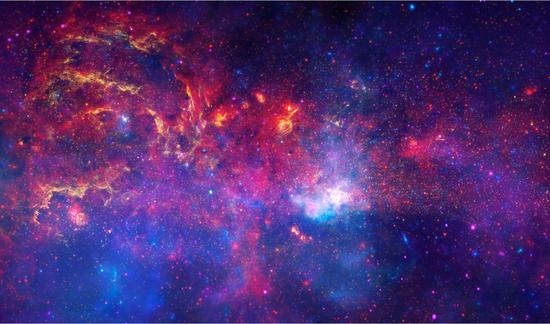X-ray Insight into High-Energy Processes in Extreme Galactic Nuclear Environment
Abstract
:1. Introduction
2. Galactic Center of our Galaxy
2.1. Accretion Flow around Sgr A*
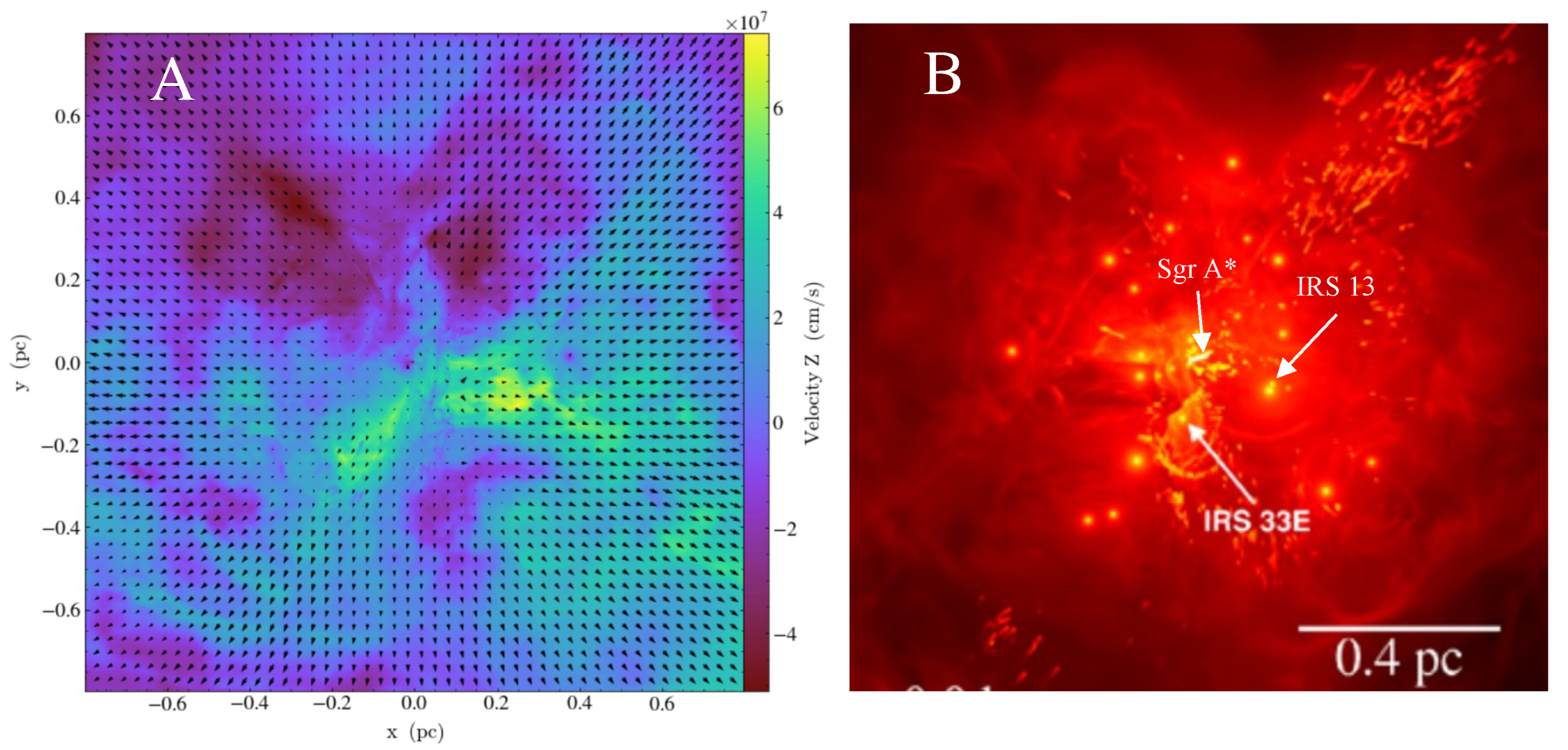
2.2. Larger Environment of the Galactic Center

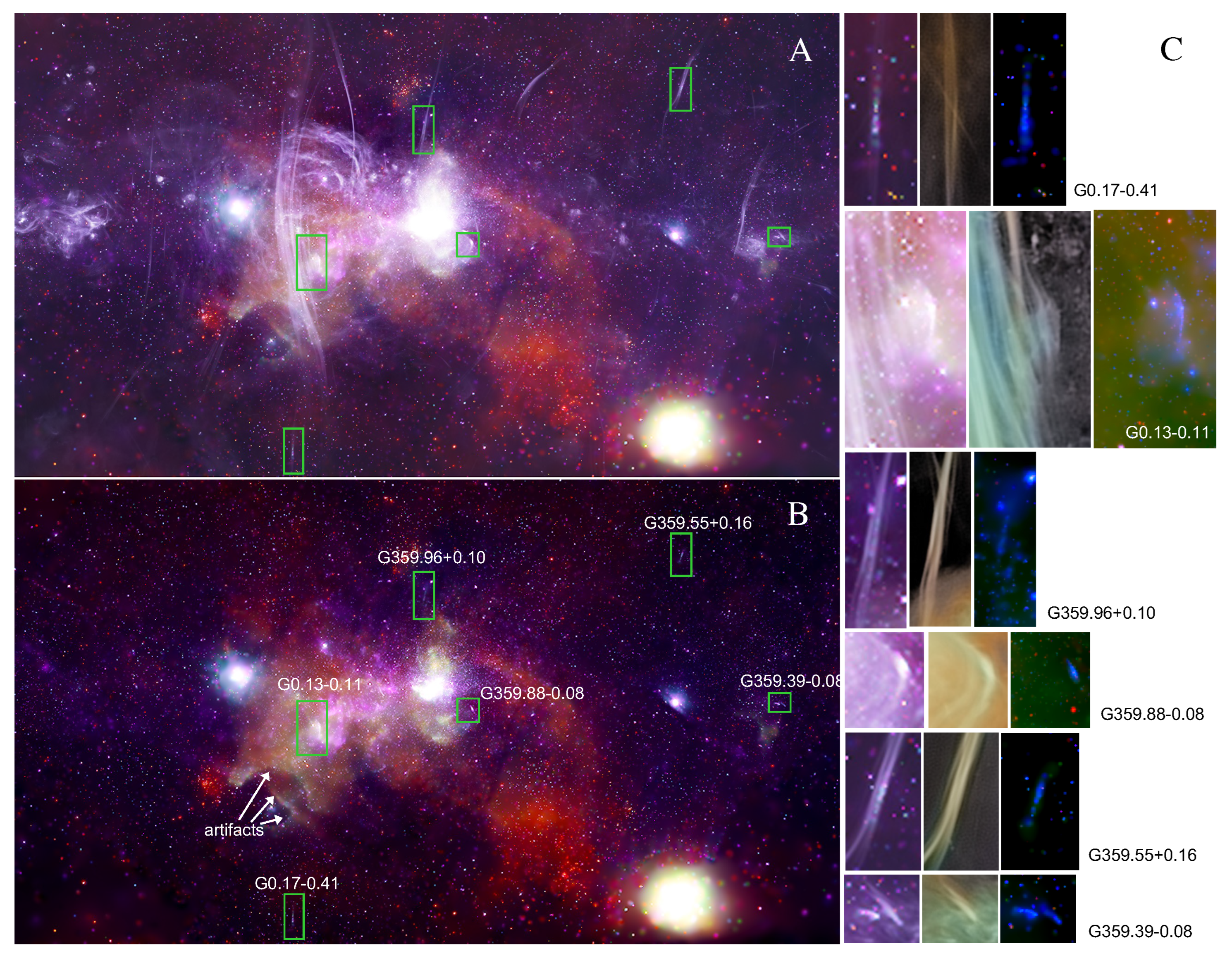
3. Evidence of an AGN Relic in M31
4. Summary and Future Prospects
- Why is Sgr A* so faint? It is surrounded by a cluster of young massive stars with strong colliding stellar winds, largely preventing cool gas from falling into the SMBH. The hot accretion is radiatively inefficient and is nearly balanced by outflow. The mass loss from the accretion flow is apparently due to the angular momentum feedback of the plasma mediated by the magnetic field [12,68]. The energetics of this outflow remains unclear, however. The observed X-ray emission arises chiefly from optically-thin thermal plasma in the ∼– Schwarzschild radius range. This is in sharp contrast to AGNs, in which X-ray emission is dominated by the innermost regions around SMBHs.
- What regulates the Galactic nuclear environment? Interstellar magnetic fields may play an important role in regulating the environment of the GC. They could be strongly amplified by differential bulk and turbulent motions (e.g., [69]) and may represent a major feedback energy source, locally and globally. The nature of numerous NTFs in the GC, as most vividly revealed by MeerKAT, remains largely uncertain, while some of them are likely organized and powered by energetic pulsars, many others may represent interstellar MR. This latter scenario is particularly interesting, but still needs to be carefully examined, both observationally and theoretically. In principle, MR can be responsible for accelerating much of the cosmic ray and heating thermal hot plasma observed in the GC. Furthermore, magnetic field energy may be transported away from the GC and released later on much larger scales, affecting the global Galactic ecosystem.
- What might be the life-cycle of galactic nuclear activity? The cycle is at least partly regulated by the natural cool gas accumulation toward galactic centers (via infall, cooling, and stellar mass-loss), star formation and AGN, and then their feedback. The recent history of the cycle may be probed by X-ray spectroscopy of the over-ionization state of hot plasma that is produced by past AGN, for example. Indeed, such over-ionization indicators have been presented for the diffuse X-ray plume south of the GC. Furthermore, high-resolution X-ray spectroscopy based on XMM-Newton RGS data suggests the presence of an AGN with a luminosity of ∼ at the center of M31 about half a million years ago. In general, if the cycling of AGN, on or off, is frequent enough, the CIE—an assumption commonly made in X-ray spectral modeling—may never be a good approximation for much of diffuse hot plasma in and around a galaxy.
Funding
Data Availability Statement
Acknowledgments
Conflicts of Interest
References
- Armillotta, L.; Krumholz, M.R.; Di Teodoro, E.M. The life cycle of the Central Molecular Zone—II. Distribution of atomic and molecular gas tracers. Mon. Not. R. Astron. Soc. 2020, 493, 5273–5289. [Google Scholar] [CrossRef] [Green Version]
- Event Horizon Telescope Collaboration. First Sagittarius A* Event Horizon Telescope Results. I. The Shadow of the Supermassive Black Hole in the Center of the Milky Way. Astrophys. J. Lett. 2022, 930, L12. [Google Scholar] [CrossRef]
- Wang, Q.D.; Dong, H.; Cotera, A.; Stolovy, S.; Morris, M.; Lang, C.C.; Muno, M.P.; Schneider, G.; Calzetti, D. HST/NICMOS Paschen-α Survey of the Galactic Centre: Overview. Mon. Not. R. Astron. Soc. 2010, 402, 895–902. [Google Scholar] [CrossRef] [Green Version]
- Wang, Q.D.; Gotthelf, E.V.; Lang, C.C. A faint discrete source origin for the highly ionized iron emission from the Galactic Centre region. Nature 2002, 415, 148–150. [Google Scholar] [CrossRef]
- Ponti, G.; Hofmann, F.; Churazov, E.; Morris, M.R.; Haberl, F.; Nandra, K.; Terrier, R.; Clavel, M.; Goldwurm, A. An X-ray chimney extending hundreds of parsecs above and below the Galactic Centre. Nature 2019, 567, 347–350. [Google Scholar] [CrossRef] [Green Version]
- Wang, Q.D. Chandra Observations of the Galactic Center and Nearby Edge-on Galaxies. arXiv 2002, arXiv:astro-ph/0202317. [Google Scholar]
- Su, M.; Slatyer, T.R.; Finkbeiner, D.P. Giant Gamma-ray Bubbles from Fermi-LAT: Active Galactic Nucleus Activity or Bipolar Galactic Wind? Astrophys. J. 2010, 724, 1044–1082. [Google Scholar] [CrossRef] [Green Version]
- Wang, Q.D.; Nowak, M.A.; Markoff, S.B.; Baganoff, F.K.; Nayakshin, S.; Yuan, F.; Cuadra, J.; Davis, J.; Dexter, J.; Fabian, A.C.; et al. Dissecting X-ray-Emitting Gas Around the Center of Our Galaxy. Science 2013, 341, 981–983. [Google Scholar] [CrossRef] [Green Version]
- Yuan, F.; Yoon, D.; Li, Y.P.; Gan, Z.M.; Ho, L.C.; Guo, F. Active Galactic Nucleus Feedback in an Elliptical Galaxy with the Most Updated AGN Physics. I. Low Angular Momentum Case. Astrophys. J. 2018, 857, 121. [Google Scholar] [CrossRef] [Green Version]
- Yuan, Q.; Wang, Q.D. A systematic Chandra study of Sgr A★-I. X-ray flare detection. Mon. Not. R. Astron. Soc. 2016, 456, 1438–1450. [Google Scholar] [CrossRef] [Green Version]
- Ma, R.Y.; Roberts, S.R.; Li, Y.P.; Wang, Q.D. Spectral energy distribution of the inner accretion flow around Sgr A*-clue for a weak outflow in the innermost region. Mon. Not. R. Astron. Soc. 2019, 483, 5614–5622. [Google Scholar] [CrossRef]
- Roberts, S.R.; Jiang, Y.F.; Wang, Q.D.; Ostriker, J.P. Towards self-consistent modelling of the Sgr A* accretion flow: Linking theory and observation. Mon. Not. R. Astron. Soc. 2017, 466, 1477–1490. [Google Scholar] [CrossRef] [Green Version]
- Corrales, L.; Baganoff, F.K.; Wang, Q.D.; Nowak, M.; Neilsen, J.; Markoff, S.; Haggard, D.; Davis, J.; Houck, J.; Principe, D. The Chandra High-resolution X-Ray Spectrum of Quiescent Emission from Sgr A*. Astrophys. J. 2020, 891, 71. [Google Scholar] [CrossRef] [Green Version]
- Russell, C.M.P.; Wang, Q.D.; Cuadra, J. Modelling the thermal X-ray emission around the Galactic Centre from colliding Wolf-Rayet winds. Mon. Not. R. Astron. Soc. 2017, 464, 4958–4965. [Google Scholar] [CrossRef] [Green Version]
- Calderón, D.; Cuadra, J.; Schartmann, M.; Burkert, A.; Russell, C.M.P. Stellar Winds Pump the Heart of the Milky Way. Astrophys. J. Lett. 2020, 888, L2. [Google Scholar] [CrossRef]
- Ressler, S.M.; Quataert, E.; Stone, J.M. The surprisingly small impact of magnetic fields on the inner accretion flow of Sagittarius A* fueled by stellar winds. Mon. Not. R. Astron. Soc. 2020, 492, 3272–3293. [Google Scholar] [CrossRef] [Green Version]
- Murchikova, E.M.; Phinney, E.S.; Pancoast, A.; Blandford, R.D. A cool accretion disk around the Galactic Centre black hole. Nature 2019, 570, 83–86. [Google Scholar] [CrossRef] [Green Version]
- Mossoux, E.; Eckart, A. The X-ray footprint of the circumnuclear disc. Mon. Not. R. Astron. Soc. 2018, 474, 3787–3807. [Google Scholar] [CrossRef] [Green Version]
- Lu, J.R.; Ghez, A.M.; Hornstein, S.D.; Morris, M.R.; Becklin, E.E.; Matthews, K. A Disk of Young Stars at the Galactic Center as Determined by Individual Stellar Orbits. Astrophys. J. 2009, 690, 1463–1487. [Google Scholar] [CrossRef] [Green Version]
- Sunyaev, R.A.; Markevitch, M.; Pavlinsky, M. The Center of the Galaxy in the Recent Past: A View from GRANAT. Astrophys. J. 1993, 407, 606. [Google Scholar] [CrossRef]
- Koyama, K.; Maeda, Y.; Sonobe, T.; Takeshima, T.; Tanaka, Y.; Yamauchi, S. ASCA View of Our Galactic Center: Remains of Past Activities in X-rays? Publ. Astron. Soc. Jpn. 1996, 48, 249–255. [Google Scholar] [CrossRef] [Green Version]
- Revnivtsev, M.G.; Churazov, E.M.; Sazonov, S.Y.; Sunyaev, R.A.; Lutovinov, A.A.; Gilfanov, M.R.; Vikhlinin, A.A.; Shtykovsky, P.E.; Pavlinsky, M.N. Hard X-ray view of the past activity of Sgr A* in a natural Compton mirror. Astron. Astrophys. 2004, 425, L49–L52. [Google Scholar] [CrossRef]
- Ponti, G.; Terrier, R.; Goldwurm, A.; Belanger, G.; Trap, G. Discovery of a Superluminal Fe K Echo at the Galactic Center: The Glorious Past of Sgr A* Preserved by Molecular Clouds. Astrophys. J. 2010, 714, 732–747. [Google Scholar] [CrossRef]
- Li, Z.; Garcia, M.R.; Forman, W.R.; Jones, C.; Kraft, R.P.; Lal, D.V.; Murray, S.S.; Wang, Q.D. The Murmur of the Hidden Monster: Chandra’s Decadal View of the Supermassive Black Hole in M31. Astrophys. J. Lett. 2011, 728, L10. [Google Scholar] [CrossRef] [Green Version]
- Muno, M.P.; Bauer, F.E.; Baganoff, F.K.; Band yopadhyay, R.M.; Bower, G.C.; Brandt, W.N.; Broos, P.S.; Cotera, A.; Eikenberry, S.S.; Garmire, G.P.; et al. A Catalog of X-Ray Point Sources from Two Megaseconds of Chandra Observations of the Galactic Center. Astrophys. J. Suppl. Ser. 2009, 181, 110–128. [Google Scholar] [CrossRef] [Green Version]
- Ponti, G.; Morris, M.R.; Terrier, R.; Haberl, F.; Sturm, R.; Clavel, M.; Soldi, S.; Goldwurm, A.; Predehl, P.; Nandra, K.; et al. The XMM-Newton view of the central degrees of the Milky Way. Mon. Not. R. Astron. Soc. 2015, 453, 172–213. [Google Scholar] [CrossRef] [Green Version]
- Wang, Q.D. Chandra large-scale mapping of the Galactic Centre: Probing high-energy structures around the central molecular zone. Mon. Not. R. Astron. Soc. 2021, 504, 1609–1618. [Google Scholar] [CrossRef]
- Johnson, S.P.; Dong, H.; Wang, Q.D. A large-scale survey of X-ray filaments in the Galactic Centre. Mon. Not. R. Astron. Soc. 2009, 399, 1429–1440. [Google Scholar] [CrossRef] [Green Version]
- Revnivtsev, M.; Sazonov, S.; Churazov, E.; Forman, W.; Vikhlinin, A.; Sunyaev, R. Discrete sources as the origin of the Galactic X-ray ridge emission. Nature 2009, 458, 1142–1144. [Google Scholar] [CrossRef]
- Nakashima, S.; Nobukawa, M.; Uchida, H.; Tanaka, T.; Tsuru, T.G.; Koyama, K.; Murakami, H.; Uchiyama, H. Discovery of the Recombining Plasma in the South of the Galactic Center: A Relic of the Past Galactic Center Activity? Astrophys. J. 2013, 773, 20. [Google Scholar] [CrossRef] [Green Version]
- Nakashima, S.; Koyama, K.; Wang, Q.D.; Enokiya, R. X-Ray Observation of a Magnetized Hot Gas Outflow in the Galactic Center Region. Astrophys. J. 2019, 875, 32. [Google Scholar] [CrossRef] [Green Version]
- Heywood, I.; Camilo, F.; Cotton, W.D.; Yusef-Zadeh, F.; Abbott, T.D.; Adam, R.M.; Aldera, M.A.; Bauermeister, E.F.; Booth, R.S.; Botha, A.G.; et al. Inflation of 430-parsec bipolar radio bubbles in the Galactic Centre by an energetic event. Nature 2019, 573, 235–237. [Google Scholar] [CrossRef] [Green Version]
- Law, C.J.; Backer, D.; Yusef-Zadeh, F.; Maddalena, R. Radio Recombination Lines Toward the Galactic Center Lobe. Astrophys. J. 2009, 695, 1070–1081. [Google Scholar] [CrossRef]
- Alves, M.I.R.; Calabretta, M.; Davies, R.D.; Dickinson, C.; Staveley-Smith, L.; Davis, R.J.; Chen, T.; Barr, A. The HIPASS survey of the Galactic plane in radio recombination lines. Mon. Not. R. Astron. Soc. 2015, 450, 2025–2042. [Google Scholar] [CrossRef]
- Nagoshi, H.; Kubose, Y.; Fujisawa, K.; Sorai, K.; Yonekura, Y.; Sugiyama, K.; Niinuma, K.; Motogi, K.; Aoki, T. The Galactic center lobe filled with thermal plasma. Publ. Astron. Soc. Jpn. 2019, 71, 80. [Google Scholar] [CrossRef]
- Yusef-Zadeh, F.; Arendt, R.G.; Wardle, M.; Heywood, I.; Cotton, W. The population of Galactic centre filaments III: Candidate radio and stellar sources. arXiv 2022, arXiv:2208.11589. [Google Scholar] [CrossRef]
- Yusef-Zadeh, F.; Morris, M.; Chance, D. Large, highly organized radio structures near the galactic centre. Nature 1984, 310, 557–561. [Google Scholar] [CrossRef]
- LaRosa, T.N.; Lazio, T.J.W.; Kassim, N.E. A New System of Parallel Isolated Nonthermal Filaments near the Galactic Center: Evidence for a Local Magnetic Field Gradient. Astrophys. J. 2001, 563, 163–171. [Google Scholar] [CrossRef]
- Yusef-Zadeh, F.; Wardle, M. Cosmic-ray-driven outflow from the Galactic Centre and the origin of magnetized radio filaments. Mon. Not. R. Astron. Soc. 2019, 490, L1–L5. [Google Scholar] [CrossRef] [Green Version]
- Sofue, Y. Galactic Center threads as nuclear magnetohydrodynamic waves. Publ. Astron. Soc. Jpn. 2020, 72, L4. [Google Scholar] [CrossRef]
- Heywood, I.; Rammala, I.; Camilo, F.; Cotton, W.D.; Yusef-Zadeh, F.; Abbott, T.D.; Adam, R.M.; Adams, G.; Aldera, M.A.; Asad, K.M.B.; et al. The 1.28 GHz MeerKAT Galactic Center Mosaic. Astrophys. J. 2022, 925, 165. [Google Scholar] [CrossRef]
- Zhang, S.; Zhu, Z.; Li, H.; Pasham, D.; Li, Z.; Clavel, M.; Baganoff, F.K.; Perez, K.; Mori, K.; Hailey, C.J. NuSTAR and Chandra Observations of the Galactic Center Nonthermal X-ray Filament G0.13-0.11: A Pulsar-wind-nebula-driven Magnetic Filament. Astrophys. J. 2020, 893, 3. [Google Scholar] [CrossRef]
- Archer, A.; Benbow, W.; Bird, R.; Buchovecky, M.; Buckley, J.H.; Bugaev, V.; Byrum, K.; Cardenzana, J.V.; Cerruti, M.; Chen, X.; et al. TeV Gamma-Ray Observations of the Galactic Center Ridge by VERITAS. Astrophys. J. 2016, 821, 129. [Google Scholar] [CrossRef] [Green Version]
- H.E.S.S. Collaboration; Abdalla, H.; Abramowski, A.; Aharonian, F.; Ait Benkhali, F.; Akhperjanian, A.G.; Andersson, T.; Angüner, E.O.; Arakawa, M.; Arrieta, M.; et al. Characterising the VHE diffuse emission in the central 200 parsecs of our Galaxy with H.E.S.S. Astron. Astrophys. 2018, 612, A9. [Google Scholar] [CrossRef] [Green Version]
- Bellan, P.M. Why current-carrying magnetic flux tubes gobble up plasma and become thin as a result. Phys. Plasmas 2003, 10, 1999–2008. [Google Scholar] [CrossRef] [Green Version]
- Bandiera, R. On the X-ray feature associated with the Guitar nebula. Astron. Astrophys. 2008, 490, L3–L6. [Google Scholar] [CrossRef] [Green Version]
- Olmi, B.; Bucciantini, N. On the origin of jet-like features in bow shock pulsar wind nebulae. Mon. Not. R. Astron. Soc. 2019, 490, 3608–3615. [Google Scholar] [CrossRef] [Green Version]
- Wang, Q.D. X-ray Jet, Counter-jet, and Trail of the Fast-moving Pulsar PSR B2224+65. Res. Notes Am. Astron. Soc. 2021, 5, 5. [Google Scholar] [CrossRef]
- Lu, F.J.; Wang, Q.D.; Lang, C.C. The Chandra Detection of Galactic Center X-Ray Features G359.89-0.08 and G359.54+0.18. Astron. J. 2003, 126, 319–326. [Google Scholar] [CrossRef] [Green Version]
- Yamauchi, S.; Shimizu, M.; Nakashima, S.; Nobukawa, M.; Tsuru, T.G.; Koyama, K. X-ray filament with a strong 6.7-keV line in the Galactic center region. Publ. Astron. Soc. Jpn. 2014, 66, 125. [Google Scholar] [CrossRef] [Green Version]
- Lazarian, A.; Eyink, G.L.; Jafari, A.; Kowal, G.; Li, H.; Xu, S.; Vishniac, E.T. 3D turbulent reconnection: Theory, tests, and astrophysical implications. Phys. Plasmas 2020, 27, 012305. [Google Scholar] [CrossRef] [Green Version]
- Furth, H.P.; Killeen, J.; Rosenbluth, M.N. Finite-Resistivity Instabilities of a Sheet Pinch. Phys. Fluids 1963, 6, 459–484. [Google Scholar] [CrossRef]
- Bicknell, G.V.; Li, J. The Snake: A Reconnecting Coil in a Twisted Magnetic Flux Tube. Astrophys. J. Lett. 2001, 548, L69–L72. [Google Scholar] [CrossRef]
- Tanuma, S.; Yokoyama, T.; Kudoh, T.; Shibata, K. Magnetic Reconnection Triggered by the Parker Instability in the Galaxy: Two-dimensional Numerical Magnetohydrodynamic Simulations and Application to the Origin of X-ray Gas in the Galactic Halo. Astrophys. J. 2003, 582, 215–229. [Google Scholar] [CrossRef]
- Pillepich, A.; Springel, V.; Nelson, D.; Genel, S.; Naiman, J.; Pakmor, R.; Hernquist, L.; Torrey, P.; Vogelsberger, M.; Weinberger, R.; et al. Simulating galaxy formation with the IllustrisTNG model. Mon. Not. R. Astron. Soc. 2018, 473, 4077–4106. [Google Scholar] [CrossRef] [Green Version]
- Sofue, Y. Molecular Fraction in the Galactic Center: The Central Molecular and HI Zones. arXiv 2022, arXiv:2208.12858. [Google Scholar]
- Nishiyama, S.; Schödel, R. Young, massive star candidates detected throughout the nuclear star cluster of the Milky Way. Astron. Astrophys. 2013, 549, A57. [Google Scholar] [CrossRef] [Green Version]
- Wiener, J.; Zweibel, E.G.; Oh, S.P. Cosmic Ray Heating of the Warm Ionized Medium. Astrophys. J. 2013, 767, 87. [Google Scholar] [CrossRef] [Green Version]
- Oka, T.; Geballe, T.R.; Goto, M.; Usuda, T.; Benjamin; McCall, J.; Indriolo, N. The Central 300 pc of the Galaxy Probed by Infrared Spectra of and CO. I. Predominance of Warm and Diffuse Gas and High H2 Ionization Rate. Astrophys. J. 2019, 883, 54. [Google Scholar] [CrossRef] [Green Version]
- Carretti, E.; Crocker, R.M.; Staveley-Smith, L.; Haverkorn, M.; Purcell, C.; Gaensler, B.M.; Bernardi, G.; Kesteven, M.J.; Poppi, S. Giant magnetized outflows from the centre of the Milky Way. Nature 2013, 493, 66–69. [Google Scholar] [CrossRef] [Green Version]
- Takasao, S.; Shuto, Y.; Wada, K. Spontaneous Formation of Outflows Powered by Rotating Magnetized Accretion Flows in a Galactic Center. Astrophys. J. 2022, 926, 50. [Google Scholar] [CrossRef]
- Bland-Hawthorn, J.; Cohen, M. The Large-Scale Bipolar Wind in the Galactic Center. Astrophys. J. 2003, 582, 246–256. [Google Scholar] [CrossRef]
- Li, Z.; Jones, C.; Forman, W.R.; Kraft, R.P.; Lal, D.V.; Di Stefano, R.; Spitler, L.R.; Tang, S.; Wang, Q.D.; Gilfanov, M.; et al. X-ray Emission from the Sombrero Galaxy: A Galactic-scale Outflow. Astrophys. J. 2011, 730, 84. [Google Scholar] [CrossRef] [Green Version]
- Li, Z.; Wang, Q.D.; Wakker, B.P. M31* and its circumnuclear environment. Mon. Not. R. Astron. Soc. 2009, 397, 148–163. [Google Scholar] [CrossRef] [Green Version]
- Dong, H.; Li, Z.; Wang, Q.D.; Lauer, T.R.; Olsen, K.A.G.; Saha, A.; Dalcanton, J.J.; Williams, B.F. Photometric evidence of an intermediate-age stellar population in the inner bulge of M31. Mon. Not. R. Astron. Soc. 2015, 451, 4126–4138. [Google Scholar] [CrossRef] [Green Version]
- Li, Z.; Wang, Q.D. Chandra Detection of Diffuse Hot Gas in and around the M31 Bulge. Astrophys. J. Lett. 2007, 668, L39–L42. [Google Scholar] [CrossRef] [Green Version]
- Zhang, S.; Wang, Q.D.; Foster, A.R.; Sun, W.; Li, Z.; Ji, L. XMM-Newton RGS Spectroscopy of the M31 Bulge. I. Evidence for a Past AGN Half a Million Years Ago. Astrophys. J. 2019, 885, 157. [Google Scholar] [CrossRef] [Green Version]
- Yuan, F.; Gan, Z.; Narayan, R.; Sadowski, A.; Bu, D.; Bai, X.N. Numerical Simulation of Hot Accretion Flows. III. Revisiting Wind Properties Using the Trajectory Approach. Astrophys. J. 2015, 804, 101. [Google Scholar] [CrossRef] [Green Version]
- Hu, Y.; Lazarian, A.; Wang, Q.D. Decomposing magnetic fields in three dimensions over the central molecular zone. Mon. Not. R. Astron. Soc. 2022, 513, 3493–3509. [Google Scholar] [CrossRef]
- Bandler, S.R.; Chervenak, J.A.; Datesman, A.M.; Devasia, A.M.; DiPirro, M.; Sakai, K.; Smith, S.J.; Stevenson, T.R.; Yoon, W.; Bennett, D.; et al. Lynx X-ray microcalorimeter. J. Astron. Telesc. Instrum. Syst. 2019, 5, 021017. [Google Scholar] [CrossRef] [Green Version]
- Liu, B.F.; Qiao, E. Accretion around black holes: The geometry and spectra. arXiv 2022, arXiv:2201.06198. [Google Scholar] [CrossRef] [PubMed]


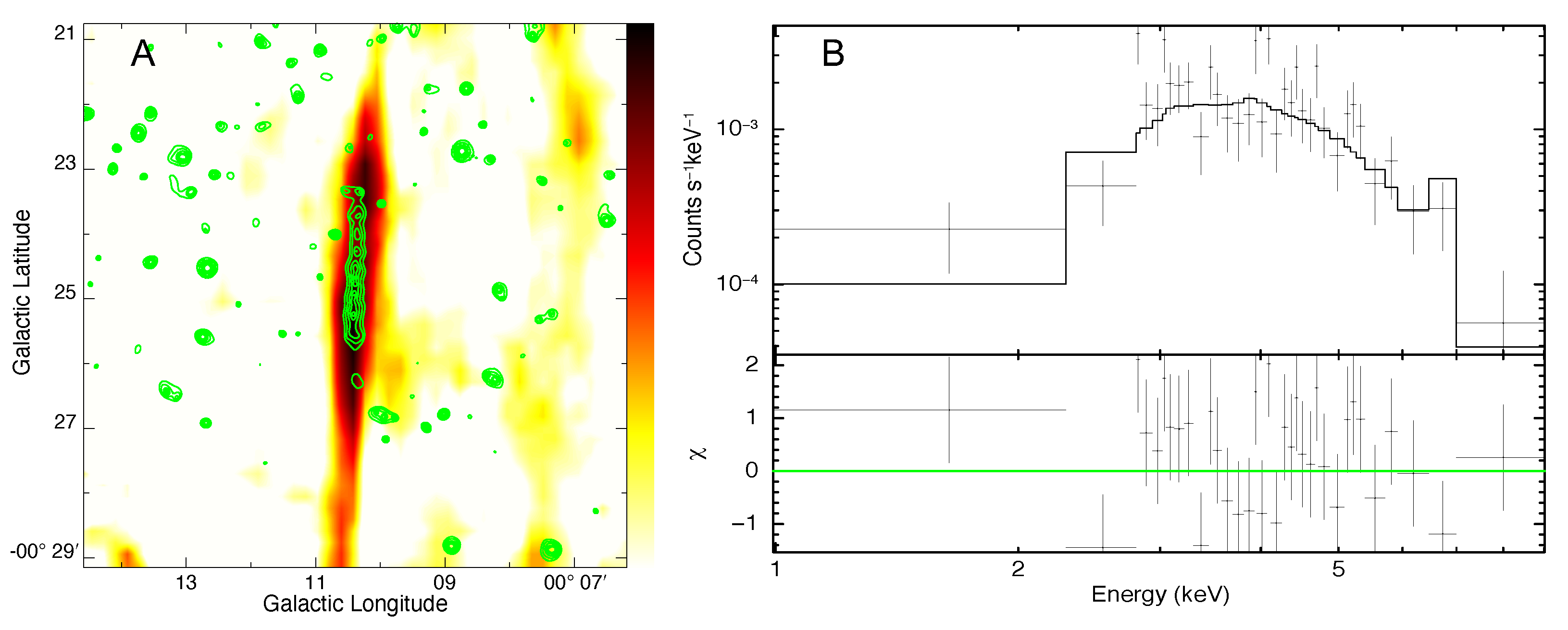

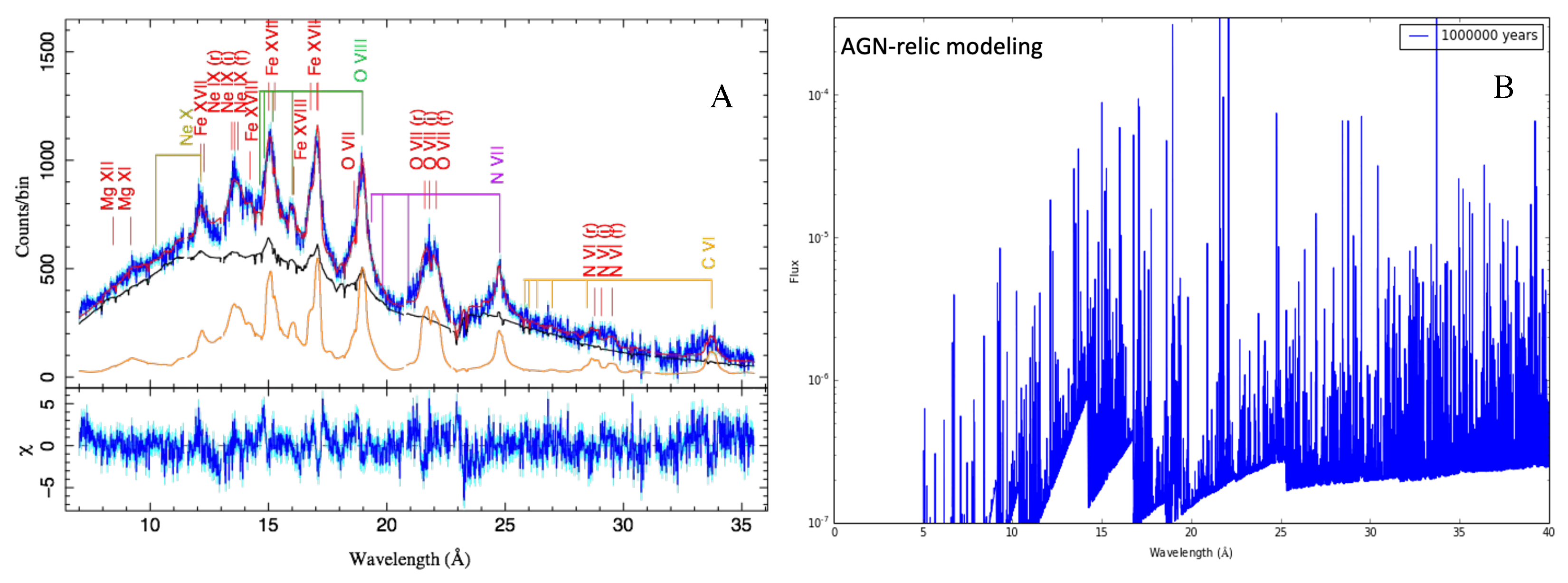

Publisher’s Note: MDPI stays neutral with regard to jurisdictional claims in published maps and institutional affiliations. |
© 2022 by the author. Licensee MDPI, Basel, Switzerland. This article is an open access article distributed under the terms and conditions of the Creative Commons Attribution (CC BY) license (https://creativecommons.org/licenses/by/4.0/).
Share and Cite
Wang, Q.D. X-ray Insight into High-Energy Processes in Extreme Galactic Nuclear Environment. Universe 2022, 8, 515. https://doi.org/10.3390/universe8100515
Wang QD. X-ray Insight into High-Energy Processes in Extreme Galactic Nuclear Environment. Universe. 2022; 8(10):515. https://doi.org/10.3390/universe8100515
Chicago/Turabian StyleWang, Q. Daniel. 2022. "X-ray Insight into High-Energy Processes in Extreme Galactic Nuclear Environment" Universe 8, no. 10: 515. https://doi.org/10.3390/universe8100515



